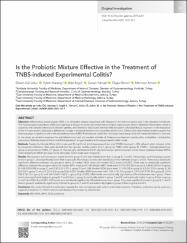| dc.contributor.author | Utku, Ozlem Gul | |
| dc.contributor.author | Karatay, Eylem | |
| dc.contributor.author | Ergul, Bilal | |
| dc.contributor.author | Yilmaz, Canan | |
| dc.contributor.author | Ekinci, Ozgur | |
| dc.contributor.author | Arhan, Mehmet | |
| dc.date.accessioned | 2020-06-25T18:34:48Z | |
| dc.date.available | 2020-06-25T18:34:48Z | |
| dc.date.issued | 2020 | |
| dc.identifier.citation | Utku, Ö. G., Karatay, E., Ergül, B., Yılmaz, C., Ekinci, Ö., & Arhan, M., (2020). Is the Probiotic Mixture Effective in the Treatment of TNBS-induced Experimental Colitis?. JOURNAL OF ACADEMIC RESEARCH IN MEDICINE-JAREM , vol.10, no.1, 41-47. | en_US |
| dc.identifier.issn | 2146-6505 | |
| dc.identifier.issn | 2147-1894 | |
| dc.identifier.uri | https://doi.org/10.4274/jarem.galenos.2019.2247 | |
| dc.identifier.uri | https://hdl.handle.net/20.500.12587/8035 | |
| dc.description | WOS: 000530895000009 | en_US |
| dc.description.abstract | Objective: Inflammatory bowel disease (IBD) is an idiopathic disease associated with changes in the immune system and in the intestinal microbiota. The most accepted hypothesis of IBD pathogenesis is thought to be the abnormal immunological response and chronic intestinal inflammation, which is caused by the complex interactions between genetic, environmental factors and the host immune system. Microbial flora is important in the maturation of the immune system. Dysbiosis is defined as changes in intestinal microbiota composition and function. Clinical and experimental studies support that dysbiosis plays a significant role in the etiopathogenesis of IBD. Probiotics are useful live microorganisms that provide the intestinal balance in the host. In this study, we aimed to evaluate the anti-inflammatory and anti-oxidant activities of Enterococcus faecium, Lactobacillus acidophilus, Lactobacillus rhamnosus, Bifidobacterium bifidum and Bifidobacterium longum bacteria in the experimental colitis model. Methods: Twenty-four female Wistar-Albino rats and 30 mg 0.5 mL trinitrobenzenesulfonic acid (TNBS) dissolved in 50% ethanol which induced colitis by intrarectal installation. Rats were divided into four groups; healthy control (sham: group A), TNBS colitis (group B), (TNBS + methylprednisolone: group C) and probiotic (TNBS + P: group D). The rats were sacrificed on the 8th day. Macroscopic and microscopic scores, tissue myeloperoxidase (MPO), malondialdehyde (MDA) and superoxide dismutase (SOD) levels were measured. Results: Macroscopic and microscopic scores levels in group A were significantly lower than in group B, C and D. Macroscopic and microscopic scores levels in group C were significantly lower than in group B. Macroscopic scores were statistically similar between group C and D. There was a statistically significant difference between the groups in terms of median MDA levels and median SOD levels (p<0.001). There was no statistically significant difference between the groups in terms of median MPO levels (p=0.114). Median MPO levels were 0.27 (0.15-0.30) in group A, 0.44 (0.22-0.61) in group B, 0.28 (0.25-0.50) in group C, and 0.30 (0.25-0.37) in group D (p=0.114). Median MDA levels were 1.1 (1.0-2.8) in group A, 4.3 (3.1-5.5) in group B, 3.8 (3.2-4.2) in group C, and 3.9 (3.1-4.2) in group D (p<0.001). Median SOD levels were 160.7 (150.1-161.7) in group A, 141.6 (137.9-147.3) in group B, 157.6 (155.2-167.7) in group C, and 164.7 (160.3-168.3) in group D (p<0.001). MDA levels were statistically significantly different between each group. These levels were significantly higher in group B, C and D than in group A; statistically similar in group C and D; and statistically higher in group B than in group C and D (p<0.001 & p=0.047). SOD levels were statistically significantly different between each group. They were significantly lower in group B, C and D than in group B; statistically significantly different in group A, C and D; and statistically higher in group D than in group A and C. Conclusion: Our study showed that probiotics regulate the balance between anti-oxidant and oxidant systems. Therefore, probiotics can be used as a supportive treatment in inflammatory bowel diseases if promoted by clinical trials. | en_US |
| dc.language.iso | tur | en_US |
| dc.publisher | Galenos Yayincilik | en_US |
| dc.relation.isversionof | 10.4274/jarem.galenos.2019.2247 | en_US |
| dc.rights | info:eu-repo/semantics/openAccess | en_US |
| dc.subject | IBD | en_US |
| dc.subject | MDA | en_US |
| dc.subject | MPO | en_US |
| dc.subject | SOD | en_US |
| dc.subject | probiotics | en_US |
| dc.title | Is the Probiotic Mixture Effective in the Treatment of TNBS-induced Experimental Colitis? | en_US |
| dc.type | article | en_US |
| dc.contributor.department | Kırıkkale Üniversitesi | en_US |
| dc.identifier.volume | 10 | en_US |
| dc.identifier.issue | 1 | en_US |
| dc.identifier.startpage | 41 | en_US |
| dc.identifier.endpage | 47 | en_US |
| dc.relation.journal | Journal Of Academic Research In Medicine-Jarem | en_US |
| dc.relation.publicationcategory | Makale - Uluslararası Hakemli Dergi - Kurum Öğretim Elemanı | en_US |
















